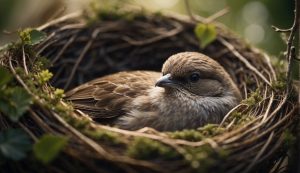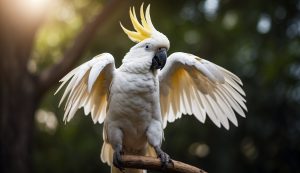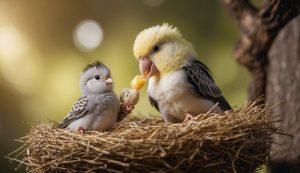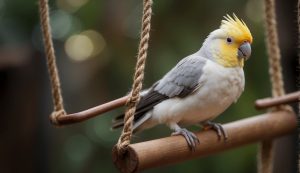Can Two Male Cockatiels Share a Cage? – Insights on Avian Cohabitation

When considering the social nature of cockatiels, one of the most common questions I come across is whether two male cockatiels can share a cage.
Understanding the behavior and needs of these friendly pet birds is crucial to answer this.
Cockatiels are known for their social interactions, so the prospect of housing them together is not far-fetched.
However, it is essential to take into account their personalities, the cage size, and whether they have been introduced properly to ensure a positive cohabitation experience.

From my experience, the key ingredients for a successful shared housing arrangement include a spacious environment, plenty of enrichment, and a watchful eye for any signs of aggression or stress.
It is not just about placing two birds in a cage; it is about creating a harmonious environment that caters to their social instincts, dietary needs, and the prevention of territorial disputes.
Careful consideration and monitoring can make cohabitation for male cockatiels a delightful experience, providing them with companionship and enrichment in their daily lives.
Key Points…
- Male cockatiels can cohabit successfully with proper introduction and space.
- A harmonious cage environment requires enrichment and attention to their social needs.
- Monitoring behavior is essential to ensure the well-being of cohabiting cockatiels.
Table of Contents
What’s Important for Cockatiels?

When considering the housing of cockatiels, their social dynamics and the importance of companionship can’t be underestimated. These aspects are crucial for their well-being and happiness.
Social Dynamics of Cockatiels
Cockatiels are social birds that thrive in a community environment; in the wild, they live in flocks. It’s in their nature to be with others of their kind, indulging in social activities such as preening and vocalizing together.
Their playful personalities often shine in social settings, but when it comes to sharing a cage, especially with same-gender cockatiels, their individual temperaments play a significant role.
While they may bond and form companionships in a shared space, territorial behavior can also arise, leading to squabbles if their cages are not sufficiently spacious or if they’re competing for resources.
Importance of Companionship for Cockatiels
Male cockatiels can be particularly friendly and affectionate, both with humans and fellow cockatiels. Their natural instincts drive them to seek bonds, which is why companionship is so important.
If I introduce another male into the same cage, I need to observe their interactions closely to ensure they coexist harmoniously.
A strong bond between male cockatiels often results in mutual preening and shared playtime, but, like any creatures, their personalities must be compatible.
Companionship can help reduce stress, and it allows for natural behaviors, such as tandem vocalizations and playful activities, to emerge. It’s my responsibility to facilitate a positive environment that nurtures these relationships.
Essentials of Cockatiel Housing
When I consider housing for my cockatiels, especially when two males share a cage, the key focus lies on ensuring enough space and proper design to minimize tension and promote a healthy environment.
Appropriate Cage Size and Features
Cage size is paramount for the well-being of cockatiels. For two male cockatiels to comfortably share a space, each bird should have enough room to flap its wings, climb, and play without encroaching on the other’s territory. A spacious cage is not just a luxury; it’s a necessity.
Ideally, a cage meant for a pair of males should be large; for cockatiel-size birds, the minimum size I recommend is at least 2 meters in length.
Here are some additional features that should be considered for the cage:
- Bar Spacing: The ideal bar spacing for a cockatiel cage is between 1/2 inch to 5/8 inch to prevent escapes or injuries.
- Multiple Perches: Provide perches at various levels to allow for natural behaviors like climbing and roosting.
- Food and Water Dishes: Separate sets of dishes help in reducing competition over resources.
Managing Territories Within a Shared Cage
Territorial behavior in males can lead to squabbles. I manage this by organizing the living space to have clear territories:
- Perches: Place perches at opposite ends of the cage to give each bird its own lookout spot.
- Feeding Stations: Separate feeding stations can help minimize competition and ensure both birds get adequate nutrition.
- Nest Boxes: If provided, nest boxes should be positioned to keep each bird’s space distinct—even if breeding isn’t the intention.
- Toys and Enrichment: Distribute toys evenly or provide duplicates to avoid possessive behavior.
Dividing the cage into two semi-private areas allows each male cockatiel a sense of ownership over its space, which can significantly reduce disputes.
A larger cage or even an aviary can further enhance the quality of life for your feathered friends by providing more space for such territorial management.
Creating a Harmonious Shared Environment
When I consider introducing two male cockatiels to share the same cage, my primary focus is on promoting a peaceful cohabitation while preventing stress and aggression. Let’s look at how this can be achieved through careful introduction and maintaining a stress-free shared space.
Introducing Two Male Cockatiels
My first step is always to ensure a gradual and patient introduction between the two birds.
To start, I set up two separate cages in the same room, allowing the cockatiels to see and hear each other without direct interaction. This approach minimizes stress and helps prevent territorial behavior as they become accustomed to each other’s presence.
After a period, which can range from a few days to a couple of weeks depending on their responses, I introduce the cockatiels in a neutral territory. This could be a stand-alone perch or a neutral room without the cages.
During these initial meetings, I observe their behavior closely, looking for signs of stress or aggression, such as hissing or lunging.
I keep these sessions short and sweet, always ending on a positive note with treats or affection, employing positive reinforcement to foster a friendly association between the two.
Avoiding Aggression and Stress in Shared Spaces
Once I see signs of acceptance, such as mutual preening or other affectionate behaviors, I feel comfortable moving to the next stage.
That said, avoiding stress and aggression, especially in shared spaces, remains crucial. Here’s how I maintain harmony:
- Attention: I make sure to distribute my attention evenly between the birds to avoid jealousy that could lead to aggression.
- Space: The shared cage needs sufficient space to allow each cockatiel his own ‘territory’. This means room for separate food bowls, toys, and perches to reduce competition.
- Supervision: Close supervision is necessary especially in the early days of sharing a cage. I remain observant for any signs of aggression, and I’m prepared to separate them if necessary.
Health, Diet, and Well-Being of Cohabiting Male Cockatiels
In my experience, maintaining the health and dietary needs of male cockatiels sharing a cage requires meticulous attention to their individual requirements. Affection and competition can both play a role in their wellbeing.
Balanced Diet and Shared Feeding
When it comes to the diet of cohabiting male cockatiels, it’s crucial to provide a balanced mix of seeds, pellets, and fresh produce to ensure that they receive all the necessary nutrients. Here’s how I manage their diet:
Seeds and Pellets:
- Seeds: Offer a variety of seeds, but in limited amounts to prevent selective feeding and obesity.
- Pellets: These should constitute the bulk of their diet, as they are nutritionally balanced.
Fresh Produce:
- Vegetables: Include dark leafy greens like spinach and kale, along with carrots and broccoli.
- Fruits: Apples and berries are great, but I avoid avocados and chocolate, which are toxic to birds.
Providing Multiple Feeding Stations:
- I use multiple feeding stations to reduce competition and ensure that each bird has access to food and fresh water.
Monitoring Food Intake:
- Paying attention to each bird’s food intake is essential; if one bird dominates, the other might not get enough to eat.
Enrichment and Activities for Two Male Cockatiels
In my experience with cockatiels, providing ample enrichment and activities is crucial for their well-being, especially when two males share a cage. Their playful personalities and need for interaction make it essential to consider both mental and physical stimulation.
Enhancing Mental and Physical Stimulation
I always emphasize the importance of designing a cage environment that encourages flying and exploration for male cockatiels living together. This promotes not only physical exercise but also mental engagement. Here’s a straightforward approach to blending both:
- Flying Space: Ensure the cage is spacious enough to allow for short flights.
- Varied Perches: Install perches of different sizes and textures to exercise their feet.
- Foraging Opportunities: Hide treats around the cage to incentivize natural foraging behavior.
The Role of Toys and Play in Joint Housing
Toys are indispensable in the joint housing of male cockatiels; they facilitate enrichment and provide opportunities for quality time together. Here’s how I like to incorporate toys:
- Interactive Toys: Puzzles or foraging toys that reward them with treats can be particularly stimulating.
- Chewable Toys: Safe wood or leather toys help keep their beaks in good shape.
- Mirror Toys: Although care should be taken as some birds can become aggressive or overbond with their reflection, mirrors can provide mental stimulation.
Considerations Before Housing Male Cockatiels Together
When considering housing two male cockatiels together, it’s vital to assess their compatibility and recognize the dedication required for dual-bird care. I’ll explore how to evaluate the temperaments of these pets and what being a responsible owner entails in this scenario.
Evaluating Compatibility and Temperament
Compatibility between two birds, especially of the same sex, hinges largely on their individual personalities. While male cockatiels can be quite social and may enjoy the company of another bird, careful observation is crucial to ensure they can bond without aggression. Here’s a simple checklist I use to monitor potential compatibility:
- Observe interactions: Watch how the birds communicate and play. Frequent aggressive episodes, like pecking or chasing, can be a red flag.
- Introduction period: Keep them in separate cages within view of each other initially to gauge reactions.
- Quarantine: New birds should be quarantined to prevent the spread of diseases before any introduction.
- Age-related behaviors: Younger males might bond more easily, while older birds can be set in their ways.
Long-Term Commitment to Dual-Bird Care
As an owner, the responsibility of caring for multiple birds is considerably greater than caring for a single pet. The key points to keep in mind include:
- Veterinary care: More birds mean more trips to the vet and the potential for higher medical expenses.
- Separate resources: Ensure that each cockatiel has its own feeder and waterer to prevent resource guarding.
- Space requirements: A larger cage, ideally double the size recommended for a single bird, is necessary to accommodate two male cockatiels comfortably.
Frequently Asked Questions
In my experience with cockatiels, they are social and generally enjoy the company of other birds.
Their interactions can vary based on individual personalities and environmental factors, so let’s address some common questions on the topic.
Is it okay for two male cockatiels to cohabit in the same habitat?
Yes, it’s perfectly fine for two male cockatiels to share a cage. They are often quite social and can benefit from the companionship.
However, it’s crucial to provide enough space for each bird to have some privacy.
Will male cockatiels display mating behaviors when housed together?
Male cockatiels may occasionally exhibit mating behaviors such as singing or showing off their feathers, even when no females are present.
This is typical as they are expressing their sociability and does not usually lead to aggression.
What are considerations for housing multiple cockatiels in a single enclosure?
When housing multiple cockatiels together, ensure the cage is spacious enough to prevent overcrowding, which can lead to stress and aggression.
Each bird should have room to flap its wings, move around freely, and have access to separate perches and feeding areas.
Can male and female cockatiels live together harmoniously in one cage?
Male and female cockatiels can live together harmoniously in one cage, but be aware that this could lead to breeding.
If you’re not prepared to handle offspring, you might want to house them separately or ensure same-gender pairings.
Should cockatiels have a companion, and does gender matter for their pairing?
Cockatiels do enjoy having a companion, and while gender can play a role in their dynamic, personality compatibility is key.
Both same-gender and mixed-gender pairings can work well if the birds get along and their environment is adequately set up.
Do male cockatiels engage in preening each other when they live together?
Male cockatiels can indeed engage in preening each other when they live together.
This behavior is a sign of affection and trust between the birds and helps strengthen their social bond.











